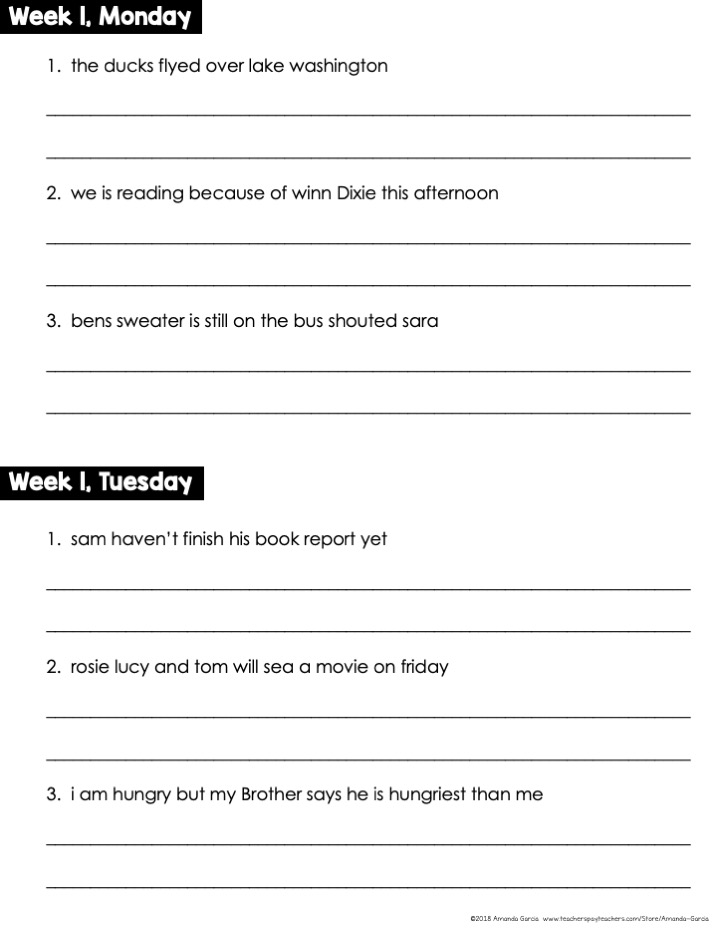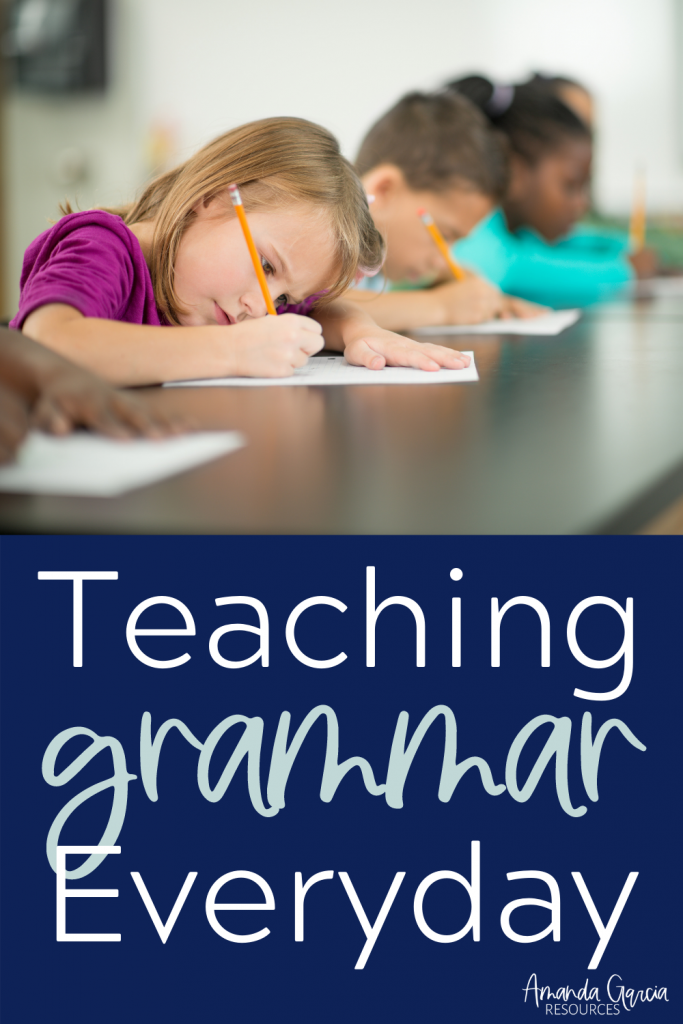
Aww, grammar. Let’s be honest – grammar is one of the first things we notice when reading. Verb agreement, punctuation, misspelled words . . . We may not be able to name what’s right about a sentence, but most of us can immediately tell when something is wrong. That ability to recognize and correct poor grammar is something teachers want to instill in their writers. The struggle, however, is teaching grammar in a way that students retain, and then apply, in their daily work. Here are 2 ways to intentionally bring grammar into the classroom.
1. Daily Oral Language
One way to successfully integrate grammar into the daily routine is through Daily Oral Language (DOL). Students read and correct mistake-laden sentences (and paragraphs depending on grade level), and then share their findings orally. The writing portion takes 5-10 minutes (and gets quicker with experience).
The booklets I created are filled with sentences that include standards-aligned grammar skills that spiral throughout the weeks. Students will see the same skills repeated as the sentences grow in complexity. Each day, they correct 2-3 kid-friendly sentences.


These DOL booklets are ideal for starting your writing block, as a bell-ringer first thing in the morning, or as an exit ticket. For online learning, Google Slides are included in the download as well! Common Core aligned DOL booklets are available for grades 2-5!
2. Student News Report
Another way to infuse grammar into the classroom is through the use of the Student News Report. Each Monday, one student is chosen to “report” to the class one newsworthy thing of their choosing. They do this by writing their “news” on a sentence strip (or any large paper.) The news shared can be anything from “We watched two movies on Saturday afternoon” to “Did you know walruses have 3 inches of blubber to keep them warm?”
Once their “news report” has been written, I hang it in the front of the room. The class begins dissecting the news report for nouns, adjectives, and verbs. We look for capitals and periods. We check for verb agreement. All of this is done as a team, because in our “news room,” we need to make sure the news is easy to read and understand.


The colors used can vary, but in my class we used pink for nouns, yellow for adjectives, and green for verbs. The news reporter gets to highlight the parts of speech in the sentence. We move on to punctuation and capitalization (allowing the writer to correct any mistakes.) It’s important to note that this activity should be started after you’ve had the time to create a safe and inclusive classroom community. Students should feel comfortable sharing, correcting their own mistakes, and asking for feedback from others. These are lifelong skills we all need to work on (regardless of age!) and won’t be perfected in the classroom, but the general idea is that students feel safe to be somewhat vulnerable in front of their peers. And of course, we want those in the “news room” trained and ready to be helpful to the news reporter, rather than critical.
When the news has been highlighted, corrected, and celebrated, the news reporter calls on 3 students who have questions about the News of the Week. At this time, the reporter gets to elaborate on their factoid. Finally, the corrected and perfected news report hangs in the front of the room for the remainder of the week.
This strategy has worked well in kindergarten classrooms (with the teacher starting out as the news reporter) all the way to 5th grade. The process takes about 15 minutes, and can take less or more time depending upon the complexity of the sentence. As an extension piece, students can copy down and illustrate the news of the week after the corrections have been made.
In order to make this a daily activity, students can record their own news of the day right inside their writer’s notebook (or on a sheet of notebook paper) each afternoon as their exit ticket. They write their news, highlight the parts of speech, edit for word choice, and make sure they have included punctuation and capitalization. Below is a FREE download so your students can try this strategy in the classroom!

At the end of the year, I love for students to go through their own news reports of the day (if they did this in their own notebooks) OR review the News Reports from the front of the room (save these!) to create a Top 10 List of newsworthy stories from Room ___! A Top 10 News Report template is included in the download so you can try this with your students, as well.
Students LOVE being the news reporter. And I love the authentic conversations we can have about grammar, word choice, and whatever fact they have chosen to share!







